| dc.contributor.author | Nordaunet-Olsen, Erik Magnus | |
| dc.date.accessioned | 2015-09-17T08:31:15Z | |
| dc.date.available | 2015-09-17T08:31:15Z | |
| dc.date.issued | 2015-06-12 | |
| dc.identifier.uri | http://hdl.handle.net/11250/300408 | |
| dc.description | Master's thesis in Petroleum geosciences engineering | nb_NO |
| dc.description.abstract | This study focusses on aspects related to carbonate build-ups in an upper Paleozoic succession in the south central Norwegian Barents Sea. Seismic and well data are used to map and characterize the protozoan and heterozoan carbonate build-ups in order to assess the factors that control their distribution within the Gipsdalen- and Bjarmeland Groups. The main objectives are (1) to describe, compare, and contrast geomorphological characteristics of the carbonate succession on the Bjarmeland and Finnmark Platforms, (2) to determine the controlling factors on the distribution of the carbonate build-up development, and lastly (3) examine the impact of evaporites on the distribution and development of the carbonate build-ups.
The upper section of the Gipsdalen Group consists of protozoan carbonates and evaporites with occasional carbonate build-ups that were deposited in an arid-warm marine environment in a global icehouse period. The Bjarmeland Group consists of heterozoan carbonates with build-ups deposited in post-glacial environment. Previous studies have suggested that faults play a role in the distribution of carbonate build-ups in the Norwegian Barents Sea.
The two areas on the Finnmark Platform (north and south) have been used in order to compare against two areas on Bjarmeland Platform (east and west). The carbonate build-up sequence observed on the eastern Bjarmeland Platform is comparable with the build-up sequence on the northern Finnmark Platform. The two areas share similarities as both are located on footwall uplifts. The geomorphology of these carbonate units are characterized as large build-up complexes. In contrast, the geomorphology of the western Bjarmeland Platform and the southern Finnmark Platform differs significantly. These units consist of polygonal build-up morphologies of reticulated arrangement with cellular structures of various scales; this depositional pattern is similar in architecture to modern patch and pinnacle reef systems observed in Holocene carbonate systems (e.g. Abrolhos Islands in Western Australia). The similarities defining these elements are that carbonate build-ups stack vertically above the layered evaporite sequence of the Gipsdalen Group. The layered evaporite sequences are observed on both platforms where salt pillows are a main characteristic. The carbonate build-ups deposit vertically above thin units of evaporites, opposed to laterally absent where the salt pillows are present, suggesting that salt has been displaced by the weight of the growing build-up. The result supports antecedent topography as a dominant component affecting the carbonate build-up succession in the eastern Bjarmeland Platform and the northern Finnmark Platform. Furthermore, the build-up development in the two areas on western Bjarmeland Platform, and southern Finnmark Platform, has been controlled by physical conditions influenced by a combination of biotic self-organization, fossil reef growth and karst-induced structures caused by dissolution of the underlying carbonate strata. The current geomorphology of the carbonate build-up succession has been enhanced due to remobilization of the mobile evaporite unit as a result of differential loading by the carbonate build-ups. | nb_NO |
| dc.description.sponsorship | Suncor Energy Norge A/S | nb_NO |
| dc.language.iso | eng | nb_NO |
| dc.publisher | University of Stavanger, Norway | nb_NO |
| dc.relation.ispartofseries | Masteroppgave/UIS-TN-IPT/2015; | |
| dc.rights | Navngivelse-IngenBearbeidelse 3.0 Norge | * |
| dc.rights.uri | http://creativecommons.org/licenses/by-nd/3.0/no/ | * |
| dc.subject | petroleumsteknologi | nb_NO |
| dc.subject | petroleum engineering | nb_NO |
| dc.subject | Bjarmeland Platform | nb_NO |
| dc.subject | Finnmark Platform | nb_NO |
| dc.subject | seismisk geomorfologi | nb_NO |
| dc.subject | petroleumsgeologi | nb_NO |
| dc.subject | geologi | nb_NO |
| dc.subject | geovitenskap | nb_NO |
| dc.subject | carbonate build-ups | nb_NO |
| dc.subject | petroleum geology | nb_NO |
| dc.subject | petroleum geosciences engineering | nb_NO |
| dc.subject | geology | nb_NO |
| dc.subject | seismic geomorphology | nb_NO |
| dc.subject | Barentshavet | |
| dc.title | Controls on upper Paleozoic carbonate build-up development in the South Central Norwegian Barents Sea | nb_NO |
| dc.type | Master thesis | nb_NO |
| dc.subject.nsi | VDP::Technology: 500::Rock and petroleum disciplines: 510::Geological engineering: 513 | nb_NO |
| dc.subject.nsi | VDP::Mathematics and natural science: 400::Geosciences: 450::Petroleum geology and petroleum geophysics: 464 | |

